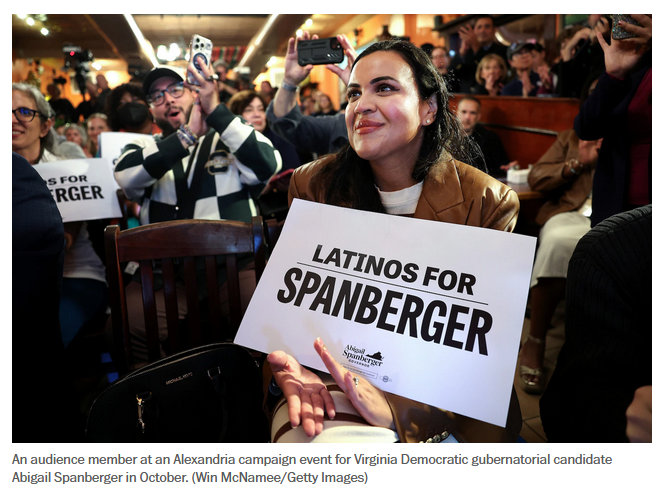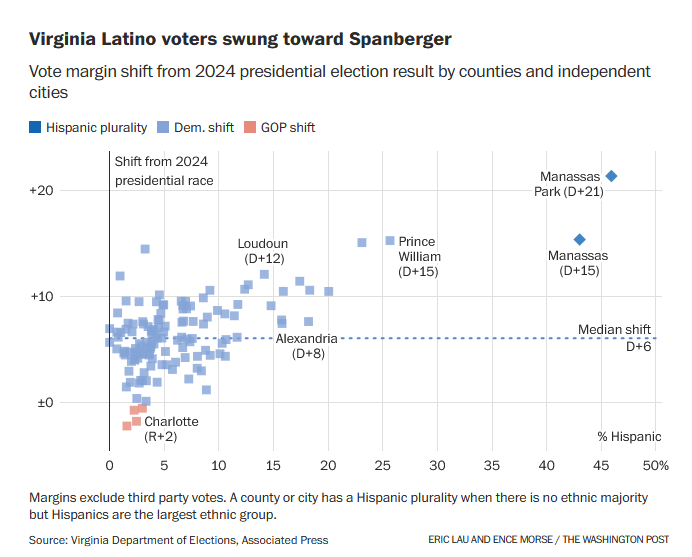The president’s deportation policies, along with high prices and changes in who turned out to vote propelled a shift in this year’s election
By Sabrina Rodriguez, Teo Armus and Hannah Knowles, The Washington Post

In New Jersey, the two counties with the highest concentration of Latino voters shifted toward Democrats more sharply than any others.
In Virginia, the heavily immigrant city of Manassas Park backed the Democratic nominee for governor by a 42-point margin — roughly double the advantage Democrats posted there in last year’s presidential race or the governor’s race three years before that.
And across this week’s elections, exit polls showed Democrats regaining strength with Latinos, sending a warning sign to Republicans who hoped to build on President Donald Trump’s inroads last year.
“I don’t think they voted in favor of the Democratic Party — they voted against what they dislike in the Republican Party,” said Jose Arango, the longtime chair of the GOP in New Jersey’s heavily Latino Hudson County, which swung 22 percentage points to the left compared with 2024.

Like other Hispanic strategists, activists and voters in both parties, he pointed to the Trump administration’s immigration crackdown as an explanation for the shift. Others also attributed it to the high cost of living that Trump vowed to rein in and a feeling that the president is focusing too much on expanding his power in Washington and not enough on improving their lives.
“Latino voters are pro-business, pro-school-choice, and pro-home-ownership and lower taxes — everything that we’re talking about as Republicans,” Arango said. But, he added, “when you start to touch the grandmother that is here for 20 years or the guy that is maybe married to an American family … you’re creating an American problem.”
Tuesday’s election results gave Democrats the strongest indicatorsyet that they are improving their standingwith Latino voters. Last year, some surveys found Trump winning nearly half of Latino voters nationwide, while Democrat Kamala Harris won them by 19 points in Virginia and just six points in New Jersey.
This year, most Democratic statewide candidates won Latino voters by at least 30 points in exit polls, re-creating the margins their party held before 2024. In New Jersey, 18 percent of Latino voters who backed Trump last year cast their ballot for the Democratic gubernatorial candidate, exit poll data showed.
Pollsters, community leaders and strategists in both parties attributed the shift to a backlash to Trump’s policies, but they also noted that turnout tends to favor Democrats in off-year elections. While some Latino Trump voters switched to Democrats, others probably stayed home, they said.
White House spokesperson Abigail Jackson defended Trump’s record, noting that inflation was higher under President Joe Biden and saying the administration is “removing dangerous criminal illegal aliens from American communities, just as promised.”
Democrats argued that Tuesday’s results bode well for the midterms but also cautioned that winning back Latino voters in New Jersey and Virginia does not necessarily translate to other parts of the country that have shifted away from Democrats, such as South Texas and South Florida.
Republicans also suggested that democratic socialist Zohran Mamdani’s winin the New York mayoral race could hurt Democrats in parts of the country where a large share of immigrants fled Cuba, Venezuela and other left-wing regimes.
In New Jersey, Democrats’ biggest gains came in Hudson County and Passaic County, which are both more than 40 percent Hispanic. Trump narrowly won Passaic last year, in a shock to Democrats. On Tuesday it swung 18 points to the left compared with 2024.
Alex Mendez, a council member in Paterson — a majority-Hispanic city in Passaic County — said he heard a lot of fear about U.S. Immigration and Customs Enforcement as he knocked on doors for Democratic gubernatorial nominee Mikie Sherrill and other candidates. That fear extended beyond undocumented immigrants to Latino U.S. citizens, he said.
“People are afraid to have a Donald Trump ally in New Jersey,” he said.
Last year, Trump capitalized on broad dissatisfaction with the economy and Democratic leadership in Washington, as he promised to lower costs. Republicans also sought to convince Latino voters that they were more aligned on social issues. Now, polling shows Latinos souring on Trump’s second term. A quarter of Hispanic adults had a “somewhat” or “very” favorable view of Trump in an October Associated Press-NORC poll, down from 44 percent in an AP-NORC poll before Trump took office.
Other polls have found that a strong majority of Latinos — and a majority of U.S. registered voters — feel Trump’s enforcement actions have gone too far.
The Trump administration has pushed aggressively to ramp up deportations with ICE agents fanning out across the country to apprehend undocumented immigrants. Videos and news reports have shown dramatic scenes of agents chasing down immigrants in their communities. At times, they have detained U.S. citizens.
In Manassas Park, more than 2 in 5 residents are Latino — the highest proportion of any county or city in Virginia — with particularly large concentrations of people from Central America and Andean countries such as Bolivia and Peru.

While more than one third of the city’s residents were born outside the U.S., they have built growing multigenerational families — with U.S. citizens who are increasingly becoming politically engaged, said Yesy Amaya, a Salvadoran immigrant and Democratic city council member who followed her family there from a closer-in D.C. suburb in 2001. Amaya, who immigrated from El Salvador to Virginia as a girl, said massive door-knocking efforts helped turn out low-propensity Latino voters who might have stayed home otherwise.
Sonia Hernandez, 25, and her brother Daniel, 22, both of whom voted for Harris in 2024, laughed as they recalled how they texted relatives on Tuesday to ensure they went to vote for Abigail Spanberger, Virginia’s Democratic gubernatorial candidate.
“We were like, ‘Did you go? You better be on it,’ said Sonia, who recently graduated from George Mason University.
“We needed to show Trump that you can’t just do whatever you want,” Daniel said, sitting at the counter of a Peruvian coffee shop in Manassas Park. “The people are gonna respond. And oh man, I feel like the people definitely showed that in Virginia.”
Reyna Corretjer, 19, who knocked doors in Manassas Park, said frustration with the Trump administration’s immigration agenda pushed her to volunteer for Spanberger’s campaign this fall. The college sophomore, who is Puerto Rican, said she has seen firsthand the fear among her family — even if they are U.S. citizens as Puerto Ricans — and friends with the heightened ICE presence in the community.
“It’s really sad seeing and hearing my family be scared to even leave the house because we hear ICE is in town at Walmart, and just like not being able to do everyday stuff that any American should be able to do,” she said.
Some of her family members backed Trump in the 2024 election, she said, but have gone from supporting him to “taking a step back and realizing that he isn’t what’s best for the country.” Most of those family members, she said, voted for Spanberger.
Both parties viewed Latino voters as up for grabs in this year’s elections. In New Jersey, both nominees for governor participated in Univision town halls and marched in Hispanic cultural parades. In Virginia, more than 100 people packed into a Tex-Mex restaurant in Alexandria days before the election for a “Latinos for Spanberger” event. There, Spanberger spoke fluent Spanish, and she and Sen. Ruben Gallego (D-Arizona) urged Latino supporters to get their families and friends out to vote.
She grew emotional as she criticized Trump’s deportations. “That should offend everyone,” Spanberger said, drawing loud applause.
Victor Escobar, a 55-year-old independent voter in the crowd, said he voted for Harris last year but had many family members who voted for Trump because they believed his promises to create jobs and improve the economy. Many now feel those promises are going unfulfilled — and some planned to vote for Spanberger, he said.
“It has been a wake-up call,” Escobar said.
William Renderos, the group’s electoral programs director, said Trump managed to pull some of those voters in his direction by highlighting grocery costs — an effort the group tried to counter through a multistep effort that started with a door-knocking campaign in the spring.
Carla Bustillos, the president of the Democratic Latino Organization of Virginia who co-led the Latinos with Spanberger coalition, said the group hosted listening sessions in January to hear from Latinos about their priorities and how they felt about the Democratic Party. What organizers found, she said, was that Latinos didn’t feel the Democratic Party spoke to their priorities — namely, tackling affordability — or offered solutions.
That created an opening, Bustillos said, for Spanberger’s pitch on affordability as the White House talked about its immigration crackdown, federal worker layoffs and budget cuts in subsequent months.
“It created the perfect storm,” Bustillos said.
Clara Ence Morse, Scott Clement and Eric Lau contributed to this report.
.
.




Be the first to comment